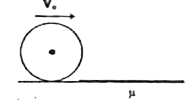A heavy chain with a mass per unit length p is pulled by the constant force F along a horizontal surface consisting of a smooth section and a rough section. The chain is initially at rest on the rough surface with x=0 . If the coefficient of kinetic friction between the chain and the rough surface is μk determine the velocity v of the chain when x=L . The force F is greater than μkpgL in under to initiate the motion ,

The correct Answer is:[√2Fρ−μkgL]
Step by step video, text & image solution for A heavy chain with a mass per unit length p is pulled by the constant force F along a horizontal surface consisting of a smooth section and a rough section. The chain is initially at rest on the rough surface with x = 0 . If the coefficient of kinetic friction between the chain and the rough surface is mu_(k) determine the velocity v of the chain when x = L . The force F is greater than mu_(k) pgL in under to initiate the motion , by Physics experts to help you in doubts & scoring excellent marks in Class 11 exams.
Topper's Solved these Questions
- BOOK - PHYSICS GALAXY - ASHISH ARORACHAPTER - NEWTONS LAWS OF MOTIONEXERCISE - Advance MCQs17videos
NEWTONS LAWS OF MOTION
- BOOK - PHYSICS GALAXY - ASHISH ARORACHAPTER - LINEAR MOMENTUM & ITS CONSERVATIONEXERCISE - exercise 1.33videos
LINEAR MOMENTUM & ITS CONSERVATION
- BOOK - PHYSICS GALAXY - ASHISH ARORACHAPTER - RIGID BODIES AND ROTATIONAL MOTIONEXERCISE - Unsolved Numerical63videos
RIGID BODIES AND ROTATIONAL MOTION
Similar Questions
A heavy chain with a mass per unite length p is pulled by the constant force F along a horizental surface consisting of a smooth section and a rough section. The chain is initially at rest on the rough surface with x=0 . If the coefficient of kinetic friction between the chain and the rough surface is μk determine the velocity v of the chain when x=L . The force F is hreater than μkogL in under to initate the motion ,
 View Solution
View SolutionA block begins to move on a rough horizontal surface with an initial velocity u. If it loses of its initial kinetic energy in time t, the coefficient of kinetic friction between the block and the surface is
View Solution
Knowledge Check
- Question 1 - Select One
A block of mass M is using on a rough horizontal surface. μR is the coefficient of kinetic friction between the block and the surface. What is the net force exerted by the surface on the block?
AMgBμMgCMg√1+μ2KDMg√1−μ2K - Question 2 - Select One
A wooden block of mass M resting on a rough horizontal surface is pulled with a force F at an angle with the horizontal. If is the coefficient of kinetic friction between the block and the surface, then acceleration of the block is -
AFM(cosϕ+μsinϕ)−μgBFsin(ϕ)MCμFcosϕD,uFsinϕ - Question 3 - Select One
A ring of mass m sliding on a smooth surface with velocity v0 enters rough surface with coefficient of kinetic friction μk, then
 Athe linear distance moved by centre of mass before the ring starts pure rolling is 3v208μkgBthe gain in kinetic energy is mv208Cthe loss in kinetic energy is mv204Dthe work done by friction force is −3mv208
Athe linear distance moved by centre of mass before the ring starts pure rolling is 3v208μkgBthe gain in kinetic energy is mv208Cthe loss in kinetic energy is mv204Dthe work done by friction force is −3mv208
A block of mass m is pulled by a constant power P placed on a rough horizontal plane. The coeficient of friction between the block and surface is μ. Find the maximum velocity of the block.
View SolutionA heavy uniform chain lies on horizontal table top. If the coefficient of friction between the chain and the table surface is 0.25, the maximum percentage of the length of the chain that can hang over one edge of the table is
View SolutionA heavy uniform chain lies on horizontal table top. If the coefficient of friction between the chain and the table surface is 0.5, the maximum percentage of the length of the chain that can hang over one edge of the table is
View SolutionA block of weight 200N is pulled along a rough horizontal surface at constant speed by a force of 100N acting at an angle 30∘ above the horizontal. The coefficient of kinetic friction between the block and the surface is
View SolutionA heavy uniform chain lies on horizantal table top. If the coefficient of friction between the chain and the table surface is 0.5, the maximum percentage of the length of the chain that can hang over one edge of the table is
View Solution

